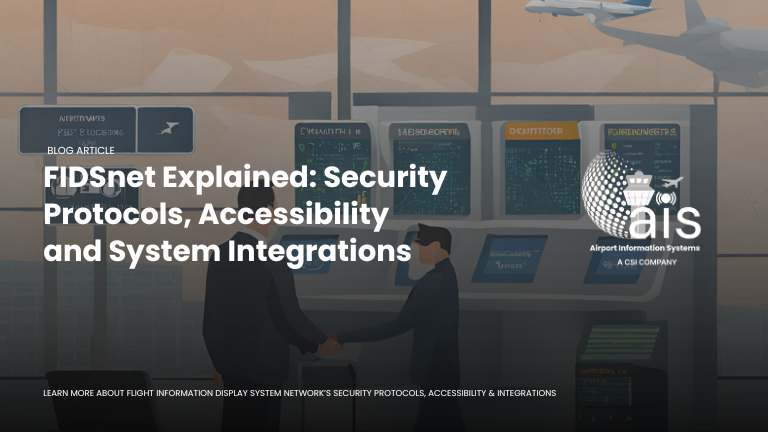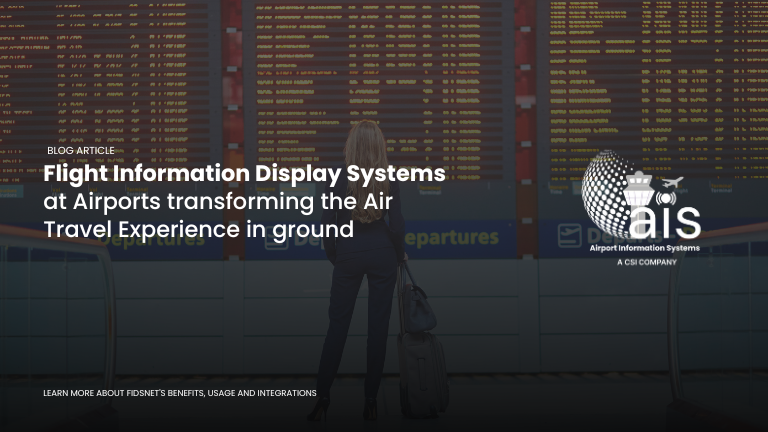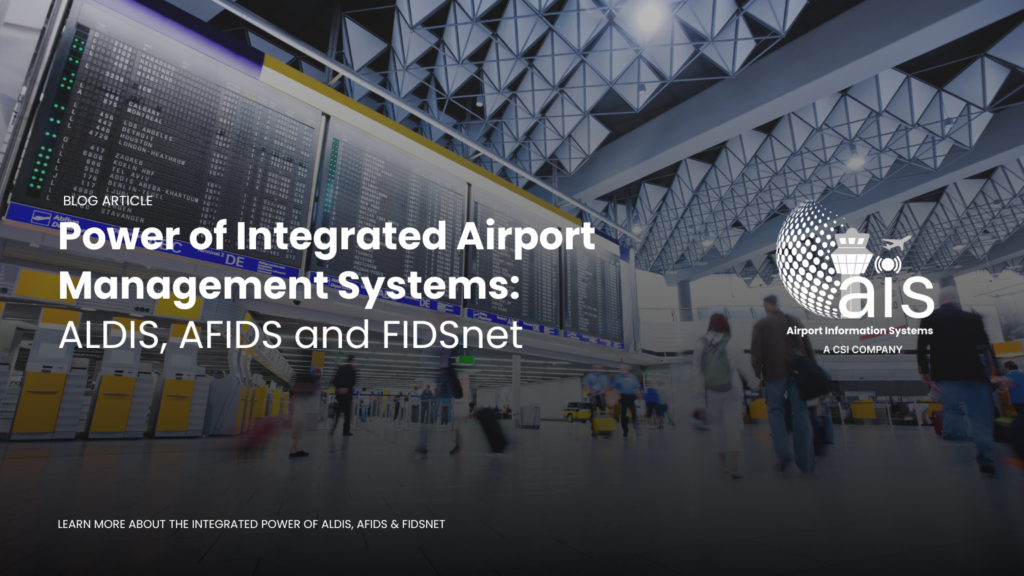- Security Architecture of FIDSNet: Ensuring Confidentiality and Integrity of Flight Information
- Technological Integration: Compatibility with Existing Display Units through Android Smart Boxes
- Customised UI for each Airport: Aligning with Unique Visual Branding of Airports
- User Accessibility
- Conclusion (TLDR)
When it comes to airport operations, the Flight Information Display System Network (FIDSNet) plays a pivotal role in keeping travelers informed about crucial details such as flight arrivals, departures, check-in procedures, baggage information, and more. This makes it essential for FIDSNet to support advanced encryptions like TLS encryption. FIDSNet ensures seamless navigation through terminals by providing real-time and comprehensive information to enhance the overall travel experience. FIDSNet not only exemplifies advanced features but places a paramount focus on security protocols, accessibility, and system integrations into the diverse landscape of airport systems.
Before we discuss about FIDSNet’s security protocols, accessibility and system integrations, check out our previous blog on FIDSNet transforming the Air Travel Experience, which explains all the basics, and advantages of Flight Information Display System Network.
Security Architecture of FIDSNet: Ensuring Confidentiality and Integrity of Flight Information
FIDSNet employs advanced encryption algorithms and secure data transmission protocols, ensuring end-to-end protection for critical flight information. The implementation of cryptographic measures safeguards against unauthorised access and tampering – guaranteeing the integrity and confidentiality of displayed data – including arrivals, departures, gate assignments, and movement remarks.
Confidentiality and integrity are of utmost importance in the aviation industry. In this regard, FIDSNet leaves no room for compromise. Rigorous measures are in place to uphold the confidentiality of every piece of flight information displayed. This not only prevents unauthorised access but also guarantees the accuracy of the data, as it is on a need-to-know basis.
FIDSNet implements stringent measures to uphold these principles, instilling trust in the accuracy and security of the displayed flight data.
FIDSNet utilises structured cabling, Wi-Fi, Power-over-Ethernet, or a standalone power supply connection for its operations. Structured cabling provides an organised approach to cabling the airport infrastructure, ensuring reliable data transmission, and reducing the risk of signal interference in the display network. This is a significant factor when it comes to security, as it cannot be wirelessly tampered with. Power-over-Ethernet combines power and data transmission through a single Ethernet cable. This eliminates the need for separate power cables, reducing cable clutter and simplifying the overall cabling infrastructure in the Flight Information Display System Network (FIDSNet). So whether you want the convenience of WiFi, or the integrity and reliability of structured cable or power-over-ethernet, FIDSNet has got you covered.
Advanced TLS Encryption
From a security standpoint, the latest version of FIDSNet now supports FTP over TLS/SSL functionality. FTP over TLS/SSL (File Transfer Protocol over Transport Layer Security / Secure Sockets Layer), as the name suggests, is a file transfer protocol that adds a layer of encryption to standard FTP. Standard FTP is a protocol used to transfer files over a TCP (Transmission Control Protocol) network, such as the Internet.
FTP over TLS is also known as FTPS. It is widely used in scenarios where secure file transfer is crucial, such as in corporate environments, financial transactions, or any situation where sensitive data needs to be transmitted securely over a network.
In simple words, FTPS transfers files between two nodes – the FIDSNet Server(Server that holds the data about Flight Information), and the Customer Server (websites that customers use to display Flight Information), over the internet, in a secure, encrypted channel. TLS and SSL are the encryption protocols that secure communication over these two nodes. This encryption further prevents unauthorised tampering of the data, which allows airports to securely upload vital flight information – including arrivals, departures, and cargo information – directly to their websites.
Technological Integration: Compatibility with Existing Display Units through Android Smart Boxes
Real-time Data Sync
Real-time data synchronisation relies on intricate data exchange protocols embedded within FIDSNet. The system facilitates seamless communication between systems, ensuring that information that is displayed aligns with the current status of flights. The ability to uplift real-time information to airport websites enhances transparency and keeps passengers informed. This ensures the online representation of flight data remains accurate and up-to-date.
Here is a live example of FIDSNet put to use, by one of our clients – Ireland West Airport Knock.
This airport recognised the need for streamlined airport operations, and incorporated all three – ALDIS, AFIDS, and FIDSNet. This trifecta has worked wonders for them as they have successfully improved their passenger experience, and optimised their resources.
Compatibility with Existing Display Units
FIDSNet’s compatibility with existing display units is facilitated by the integration of Android Smart Boxes. This not only reduces implementation costs but also ensures a smooth transition for airports with pre-existing infrastructure. This synergy also enhances the visual presentation, providing a dynamic and engaging platform for flight information. The compatibility with existing display units through Android Smart Boxes exemplifies the technical adaptability and cost-effectiveness of FIDSNet.
Customised UI for each Airport: Aligning with Unique Visual Branding of Airports
The Screen Configuration Utility tool
FIDSNet empowers airports with the Screen Configuration Utility tool that allows the customisation of the user interface to align with each airport’s unique branding guidelines. This level of customisation ensures that the system integrates seamlessly into the distinct visual identity of every airport.
The mouse-over function within the Staff Information System adds a layer of sophistication, allowing users to access detailed movement remarks of the aircraft swiftly and effortlessly.
Miniscule adjustments – Right to the Pixel Level
FIDSNet enables fine design adjustments, granting airports the flexibility to tailor the user interface according to their preferences, including finely adjusted fonts, sizes, positions of elements, colors, and displayed content. This nuanced customisation ensures that the visual representation remains cohesive with the airport’s design guidelines.
Acknowledging the individuality of each airport, FIDSNet aligns with its unique visual branding. This tailored approach ensures that the system not only meets functional requirements but also becomes an organic extension of the airport’s overall aesthetics. The system leverages modern display technologies to their fullest potential, ensuring that the presentation of flight information is both informative and visually captivating.
User Accessibility
Behind the user-friendly interface lies a complex framework of sophisticated data structures. User accessibility is as critical as the user interface in airport systems, benefiting both passengers and operators. For passengers, it ensures a positive and inclusive experience, especially for those with diverse conditions. Clear signage, easy navigation, and inclusive features contribute to a stress-free experience.
Simultaneously, for airport operators, a system with a cohesively organised dashboard and ease of accessibility streamlines operations, reducing errors and enhancing efficiency in managing airport operations and communications.
Efficient Algorithms for Seamless Data Management
FIDSNet optimises data management through intricate structures, ensuring efficient accessibility and retrieval of information. Flight Information Display System Network uses the real-time data of the AFIDS software to display, in a configurable format, relevant information on screens around the airport.
It navigates through a labyrinth of sophisticated data structures, where the system enables swift retrieval and efficient management of vast datasets. These datasets, combined with AI algorithms streamline data processing, contributing to a seamless and swift user experience. Through intricate algorithms, the system ensures seamless data management that fosters an airport ecosystem where information flows effortlessly.
Conclusion (TLDR)
Flight Information Display Systems Network (FIDSNet) stands as a critical system for passenger information, terminal navigation and beyond. FIDSNet by Airport Information Systems prioritises security, accessibility, and integration into your existing airport systems architecture.
The latest version of FIDSNet now supports FTP over TLS/SSL functionality, which allows airports to securely upload vital flight data – including arrivals, departures, and cargo information – directly to their websites.
AIS product suite employs cutting-edge encryption and secure data transmission protocols, ensuring the confidentiality and integrity of critical airport and flight information. Rigorous measures, including structured cabling and Power-over-Ethernet, fortify the system against unauthorised access.
FIDSNet’s integration with other AIS products boasts real-time data synchronisation and compatibility with existing display units through Android Smart Boxes. The system’s adaptability is evident in its Screen Configuration Utility, allowing airports to customise the user interface and experience, accessible by both the passengers and the airport operators, aligning with the airport’s unique branding. Accessibility is further enhanced by sophisticated algorithms, ensuring seamless data management and swift retrieval.
The system not only meets the functional requirements of displaying flight information, but also elevates the overall airport experience for passengers and staff alike.
Interested to know more about FIDSNet to transform your airport’s operations?


